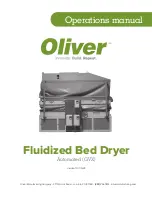
5
Chapter 2
Functional Operation of the
Fluidized Bed Dryer
The DVX family of Fluidized Bed Dryers (FBD) is based on Olivers legendary Voyager and
Maxi- Cap Gravity Separators. Unlike the gravity separator, which is designed to separate
like particles of different specific gravities, the FBD is designed to remove moisture, and
possibly heat, from the particles on the deck. Though the function is slightly different, it
works on a very similar concept as the gravity separator.
The FBD operates on a concept discovered by Archimedes, a Greek philosopher and
mathematician, who discovered that All bodies, floating in or submerged in a liquid, are
buoyed up by a force exactly equal to the weight of the liquid they displace. In the case
of the FBD, the liquid is the air blown by the fans, and the bodies are the particles being
dried. What Archimedes was getting at is that we can use air to lift the particles on the
deck, and that the amount of air needed is related to the weight of the particles that need
to be lifted.
As the air moves past the particles it acts in the same way a swamp cooler does by
evaporating the water around the particles. Because it takes a large amount of energy to
change the state of the water from a liquid to a vapor, the surrounding air becomes cooler
as it passes the particles on the deck, as the energy needed to switch the state of the
water comes from the air, and from the particles themselves. Hotter air from the fans will
speed up the drying process because it has more heat that can be dissipated to the water,
increasing the rate at which the water changes state. This process of the water being
evaporated and the air being cooled as it passes through the seeds allows us to monitor
how dry the seed is as it passes over the deck. If the air is at the same temperature above
and below the particles, then there must not be any evaporation, and the seed is dry.
In order to move the seed along the deck, there must be a process that allows the seed
to propagate. This is done via the Deck Shake and the Deck End Raise. The Deck Shake
also helps with the lifting of the seed as it gives momentum to the particles, as well as
providing a mechanism for separating out the particles that are clumped together from
being wet. The Deck End Raise allows gravity to assist or resist the movement of the
particles on the deck.
With the combination of the air, the Deck Speed, and the Deck End Raise, the particles
will enter a quasi-fluidic state, meaning that the particles will almost act like a liquid,
moving along the deck. As the air is increased, the particles will start to move more
vertically in a layer, and the deck speed and end raise will drive the product down the
deck like a liquid. The faster the deck speed and the steeper the end raise from feeder
to discharge, the faster the particles will move. The higher the air speed the faster the



























